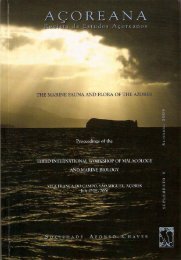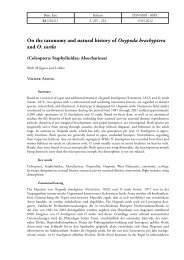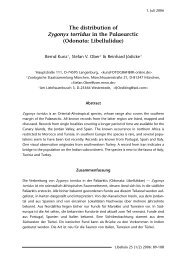(eds.) (2005). - Portal da Biodiversidade dos Açores - Universidade ...
(eds.) (2005). - Portal da Biodiversidade dos Açores - Universidade ...
(eds.) (2005). - Portal da Biodiversidade dos Açores - Universidade ...
You also want an ePaper? Increase the reach of your titles
YUMPU automatically turns print PDFs into web optimized ePapers that Google loves.
1. Introduction<br />
Nowa<strong>da</strong>ys, everybody agrees that the rate species<br />
become extinct is abnormally high. As a<br />
consequence, diversity of life is diminishing<br />
(Lawton & May 1995; Pimm et al. 1995, 1996;<br />
Chapin et al. 2000). This is one of the main<br />
environmental problems mankind has to face<br />
during the XXIth century (http://www.biodiv.org).<br />
Its solution depends on finding the answer to<br />
three consecutive questions: What is the true<br />
extent of the current crisis?; What are we doing<br />
wrong for the crisis to appear in the fist place?;<br />
How can we diminish such critical effects? The<br />
first rational step is to obtain reliable knowledge<br />
of until unknown role of biodiversity and its<br />
functioning. Then we need to concentrate on<br />
how it can be preserved from human-induced<br />
impacts. Thus, scientists from many biological<br />
fields have changed or enlarged the focus of their<br />
investigations to create a new inter-disciplinary<br />
science called Conservation Biology, which tries<br />
to answer these three questions by providing a<br />
framework for the preservation of biodiversity.<br />
Both life and human impacts occur in space.<br />
Therefore, conservation planning is in part a<br />
spatial exercise, where only biodiversity features<br />
that can be mapped are useful (Brooks et al.<br />
2004a). Therefore, the role of biogeography<br />
(the biological field studying the geography of<br />
life; see Brown & Lomolino 1998) is of major<br />
importance to the development of Conservation<br />
Biology. Whittaker and collaborators (<strong>2005</strong>) have<br />
recently defined Conservation Biogeography as<br />
“the application of biogeographical principles,<br />
theories, and analyses, being those concerned with<br />
the distributional dynamics of taxa individually<br />
and collectively, to problems concerning the<br />
conservation of biodiversity”. However, current<br />
knowledge on biodiversity patterns and processes<br />
is yet insufficient to provide social actors and<br />
decision-makers with unquestionable models<br />
and scenarios to be used to decide conservation<br />
policies (see discussion in Whittaker et al. <strong>2005</strong>).<br />
Conservation biology should thus provide a<br />
solid framework to conciliate current knowledge<br />
73<br />
1. Introdução<br />
Presentemente, não existem dúvi<strong>da</strong>s de que a taxa<br />
de extinção de espécies é anormalmente eleva<strong>da</strong>,<br />
estando a diversi<strong>da</strong>de biológica a diminuir (Lawton<br />
& May 1995; Pimm et al. 1995, 1996; Chapin et al.<br />
2000), sendo esta diminuição um <strong>dos</strong> maiores problemas<br />
ambientais que a espécie humana tem de<br />
enfrentar durante o séc XXI (http://www.biodiv.org).<br />
A sua solução depende <strong>da</strong> resposta sucessiva a três<br />
questões: Qual a ver<strong>da</strong>deira extensão <strong>da</strong> crise<br />
actual?; Que estamos a fazer de modo errado que<br />
deu origem à crise existente?; Como podemos diminuir<br />
o impacto desses efeitos críticos? O primeiro<br />
passo racional para resolver o problema será obter<br />
um melhor conhecimento acerca do papel <strong>da</strong> biodiversi<strong>da</strong>de<br />
e do seu funcionamento e também como<br />
pode ser defendi<strong>da</strong> de impactos induzi<strong>dos</strong> pelos<br />
seres humanos. Nesse sentido, cientistas de muitos<br />
campos <strong>da</strong> Biologia modificaram ou alargaram o<br />
foco <strong>da</strong>s suas investigações para formar uma nova<br />
ciência interdisciplinar, a biologia <strong>da</strong> Conservação,<br />
que tenta responder às três questões apresenta<strong>da</strong>s<br />
fornecendo uma estrutura para a planificação <strong>da</strong><br />
preservação <strong>da</strong> biodiversi<strong>da</strong>de.<br />
O espaço é necessário à vi<strong>da</strong>, e é no espaço que<br />
se observam os impactos que se exercem sobre os<br />
seres vivos. Consequentemente, a planificação <strong>da</strong><br />
conservação é em parte um exercício espacial, onde<br />
apenas as características <strong>da</strong> biodiversi<strong>da</strong>de que<br />
podem ser cartografa<strong>da</strong>s são úteis (Brooks et al.<br />
2004a). O papel <strong>da</strong> biogeografia (campo biológico<br />
que estu<strong>da</strong> a geografia <strong>dos</strong> seres vivos; ver Brown<br />
& Lomolino 1998) é essencial para o desenvolvimento<br />
<strong>da</strong> Biologia <strong>da</strong> Conservação. Whittaker e os<br />
seus colaboradores (<strong>2005</strong>) definiram recentemente<br />
Biogeografia <strong>da</strong> Conservação como “a aplicação<br />
de princípios biogeográficos, teorias e análises<br />
respeitantes à dinâmica de distribuição de taxa,<br />
individuais ou colectivos, a problemas <strong>da</strong> conservação<br />
<strong>da</strong> biodiversi<strong>da</strong>de”. Contudo, o conhecimento<br />
<strong>dos</strong> padrões e processos <strong>da</strong> biodiversi<strong>da</strong>de é ain<strong>da</strong><br />
insuficiente para fornecer aos actores sociais e aos<br />
decisores, modelos e cenários seguros para a definição<br />
de políticas de conservação (ver discussão<br />
em Whittaker et al. <strong>2005</strong>). A Biologia <strong>da</strong> Con-

















